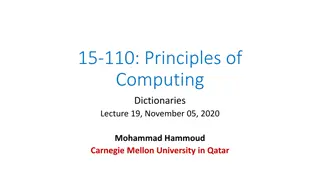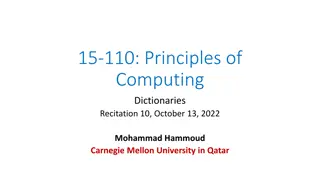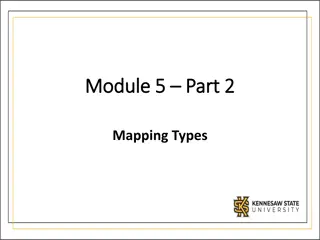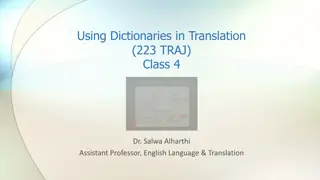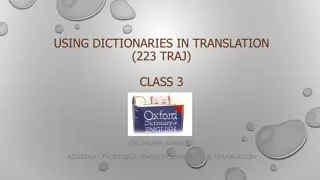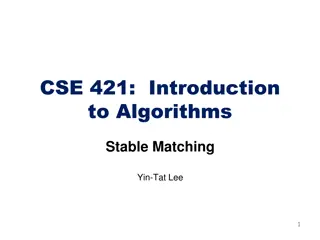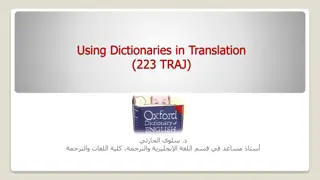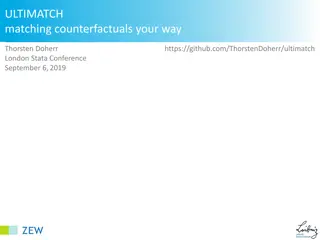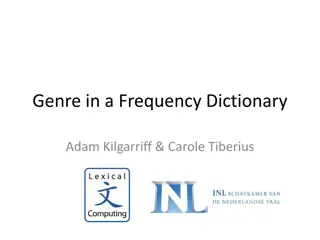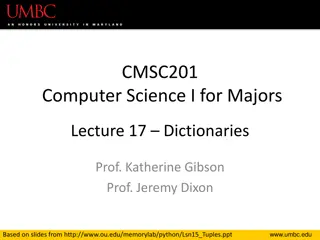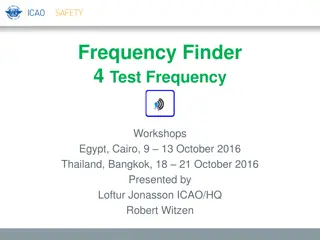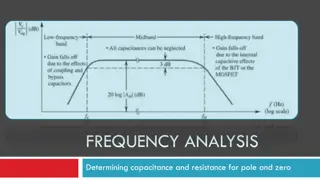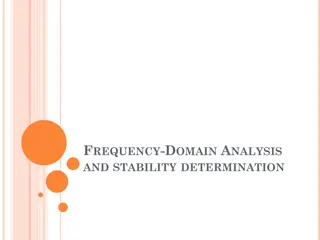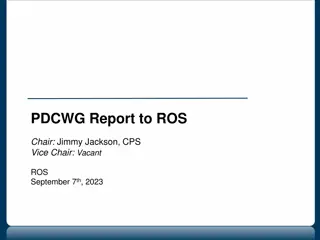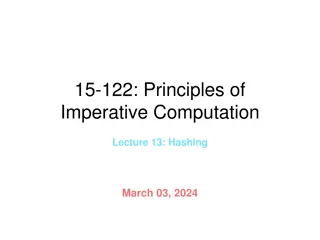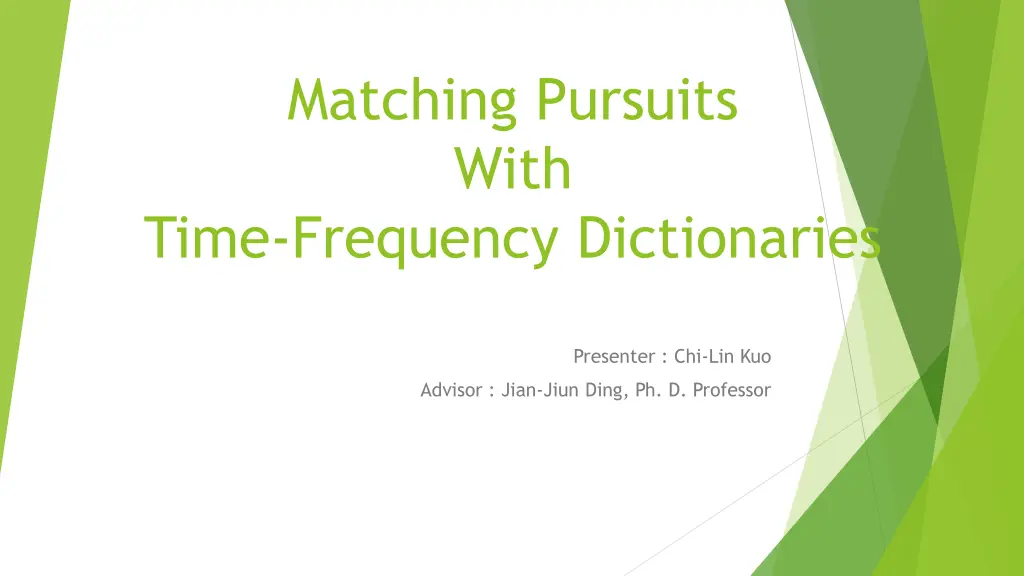
Matching Pursuits with Time-Frequency Dictionaries Overview
Explore the methodology of Matching Pursuits with Time-Frequency Dictionaries, a valuable algorithm for signal decomposition into waveforms. Learn about atom definitions, energy density functions, Gabor dictionaries, decomposition processes, and more. Discover how this approach enhances signal analysis and processing efficiency.
Download Presentation

Please find below an Image/Link to download the presentation.
The content on the website is provided AS IS for your information and personal use only. It may not be sold, licensed, or shared on other websites without obtaining consent from the author. If you encounter any issues during the download, it is possible that the publisher has removed the file from their server.
You are allowed to download the files provided on this website for personal or commercial use, subject to the condition that they are used lawfully. All files are the property of their respective owners.
The content on the website is provided AS IS for your information and personal use only. It may not be sold, licensed, or shared on other websites without obtaining consent from the author.
E N D
Presentation Transcript
Matching Pursuits With Time-Frequency Dictionaries Presenter : Chi-Lin Kuo Advisor : Jian-Jiun Ding, Ph. D. Professor
Outlines Introduction Concepts of matching pursuit Decomposition Back projection The choice function The number of iteration The convergence Definition of atom Energy density function The Gabor dictionaries and the formulation for discrete implementation Conclusion Reference
Introduction ? = 3,? = 5,? = 5 ? = 5,? = 6,? = 8 ? = 6,? = 3,? = 10
Introduction Matching pursuit is an iteration algorithm, that decomposed any signal into a linear expansion of waveforms that belong to a redundant dictionary of functions. These waveforms are selected in order to best match the signal structures. Although a matching pursuit is nonlinear, like an orthogonal expansion, it maintains an energy conservation which guaranties its convergence
Introduction ? ? 2?? < + ? = ? ? ?(?) ?? < ?,? > = H : Hilbert space ? : index set of vectors ?? ? ? ? } D : dictionary ? : linear span of ?. ?.?. ? = ???? ? ? ?? ? ? is complete if and only if ? = ?.
Introduction Two major dictionaries for the decomposition 1. Fourier transform dictionary --- atom: ??2??? 2. Wavelet transform dictionary 1 ? ? ? ?? --- atom: g is the mother wavelet But they are in some sense not flexible enough
Decomposition ? = ?,??0??0+ ?? ??? : the residual vector of ? after ? successive projections, ?0? = ? It is clear that the residue vector of f is orthogonal to ??0 ?,??0 sup ?,?? ? ? where is an optimal factor that satisfies 0 ? 1.
Decomposition A matching pursuit is an iterative algorithm we are to select ??? ??? = ???,??????+ ??+1? such that ???,??? ???,?? sup ? ? where is an optimal factor that satisfies 0 ? 1.
Decomposition ? = ?0?,??0??0+ ?1? = ?0?,??0??0+ ?1?,??1??1+ ?2? = ? 1 ???,??????+ ??? = ?=0 ? 1 2+ ??? 2= ??,??? 2 ? ?=0 2= 1 ???
Decomposition If the dictionary D is complete, for ? ? ?=? 1 < ???,???>??? ? = ?=0 The vector ? is characterized by the sequence of two entries ???,???,?? This sequence is called the structure book Two special cases Smallest complete dictionary : basis Largest complete dictionary : All vectors in H
Back - projection ? be the orthogonal complement of ? in ? ??and ??be the projectors over ? and ? ?=? 1???,??????+ ??? f = ?=0 at the mthiteration there are m vectors (???,n = 0, ,m 1) already determined. Let ??be the subspace spanned by these vectors ?=? 1 ???,??????+ ?????? ???? = ?=0
Back - projection ?=? 1???,??????+ ?????? ???? = ?=0 ?=? 1???,?????? A???????????? ? ?=0 it may not be the best approximation , the reason is that in general ?????? 0. i.e. ?????? = ?=0 ?=? 1????? Structure book : replace ??,???by ??,???+ ??
Back - projection To find ??we take an inner product with ??? ? 1 ??????,???= ?????,??? ?=0 the coefficients can be known by solving this linear system. With back-projection, the error becomes 2 ???? 2= ???? 2= ?????? 2= ??? 2 ??? 2 ?????? 2 ?
The choice function When the dictionary is very redundant, we can limit the space of search to a sub- dictionary. Let ?? ? sup ? ?? ?,?? ?sup ?,?? ? ? where is an optimal factor that satisfies 0 ? 1. The size of ??can be much reduced from that of ? for most of the case. Then we defined the sub-dictionary ??by ??| ??
The choice function First search is in ??. ???,? ???,?? ??= sup ? ? Second search in a neighborhood of ? ??with Newton method find an element ???where ???,??? ???,??? ???,? reaches a local maxima ?sup ?,?? ?? ? ? We compute the inner product with all ?? ?? ??? = ???,??????+ ??+1? ??+1?,?? = ???,?? ???,??????,??
The number of iteration The number of iteration is determined by the precision we desire If the desired precision is , the number of iteration is the minimum ? such that ? 1???,??? ??? = ? ?=0 ? ? this is equivalent to 2 ? ? ? 1???,??? 2 ?=0 ?
The convergence To realize the decay rate of the energy of residual vector ??? , we defined the correlation ratio of a function ? ? with respect to ? by ?,?? ? ? = sup ? ? ? ? = inf ? ??(?) > 0.
The convergence ???,??? ???,?? = ?? ??? ??? ?sup ? ? 2 ??+1? 2= ??? 2 ???,??? ??? 2 ?2?2??? ??? 2 1/2 ??+1? ??? 1 ?2?2??? 1 2 ? 11 ?2?2??? ??? ? ?=0 ? 2 1 ?2? ? ?
Definition of atom To carry out matching pursuit, dictionaries of time-frequency atoms are mostly considered A general family of time-frequency atoms can be generated by scaling, translating and modulating a window function ? ? H 1.? ? is real, continuously differentiable 1 2.O( ?2+1) 3. ?(?) = 1 4.The integral of ?(?) is nonzero 5.? 0 0
Definition of atom Let ? > 0 be the scale, ? be the frequency modulating and ? be the translation in time. We define the vector ? and index set ? by ? = ?,?,? ?+ ??= ?. Then we define time-frequency atoms 1 ?? ? ? ? ???? ??? = which the factor 1/ ? normalize the norm to be 1. The family ? = ??? ?(?), we select a countable subset {???? ? ?} is extremely large. To represent efficiently function ? ? with ??= ??,??,?? so that ? ? = ?????(?) ?=
Definition of atom When the real signal ? ? is to be decomposed to real expansion, real time-frequency atoms must be used. It is defined as ??,? ? =??,? ? ? ? ? ? cos ?? + ? ??,?is a constant that normalized the norm of ??,? ? to 1 The dictionary is thus defined by ? = ??,?|? ?,? 0,2? The matching pursuit with this dictionary is to decompose real ? ? by ???,???,?????,??? ? ? = ?=0 ??,? ? =??,? ?????? + ? ???? ? 2 ? = (?,?,?) and ? = ?,?, ?
The energy density function Wigner distribution function (WDF) of functions ? ? and ? ? is defined by ? ? +? ? ? ? ????? W?, ?,? = 2 2 And the Wigner distribution of ?(?) is ???,? = ??,??,? . Since the time-frequency dictionary is complete for ? ? we write ???,?????? ? = ?=0 The WDF of it is 2?????,? + ???,??? ???,??? ???,??? ????,????,? ???,? = ?=0 ? ? ?=0 ?=0
The energy density function ?+? ? ? ??? ?+? ? ?? ? ? 2 ? ? 2 ? ? ? 2? 1 1 1 ?? 2? ????? ????,? = ?? 2? 1 2? 1 2? 2 1 ? ? ? ? ? ? ? ? ? ? ? ? ? ? ??? = ?? + 2? ? +? ? ? ? ? ? ?? ? ? ? ?? = ? 2 ? 2 ? ? ? = ?? ,? ? ? 2?????,? ???,??? ???,? = ?=0
The energy density function 2?????,? ???,??? ???,? = ?=0 2?? ? ?? ?? ???,??? ???,? = ?=0 ,??? ?? For real decomposition 2 1 2 ???,???,?? ???,? = ????,?? ?,? + ???? ,?? ?,? ?=0 =1 ? ?? ?? ? ?? ?? 2?? ???,???,?? 2 ?=0 ,??? ?? + ?? ,??? + ??
The Gabor dictionaries and the formulation for discrete implementation ? ? is a Gaussian window defined as ? ? = 21/4? ??2 ??? are called Gabor functions 2 ? 2? ???,? = 2? 2? ?2+
The Gabor dictionaries and the formulation for discrete implementation The number of samples in the input signal be ? The scale s can only vary between 1 and ? The input signal and the Gaussian windows are expanded to be periodic with period ? The step size of time is 1 and that of frequency is 2?/? So the vector index is in the form = ?,?,2??/? with ? 1,? , ?,? ?, 0 ? < ? and 0 ? < ?. The Hilbert space ? is defined as the space of discrete signals of period ?, which has dimension ?.
The Gabor dictionaries and the formulation for discrete implementation ?? ? ?? ? ? ?= ??? = ? ??normalize the norm of ??to unity 2?? ? ??? = ??? ? ?? ? For real decomposition with ? 0,2? 2?? ?? + ? ??,? ? = ??,???? ? cos ??,?normalize the norm to unity.
The Gabor dictionaries and the formulation for discrete implementation A signal of 512 samples was built by adding chirp functions, truncated sinusoidal waves and waveforms of different time-frequency localizations Figure.1: The testing waveform [1]
The Gabor dictionaries and the formulation for discrete implementation Figure.2: Time-frequency energy distribution of the signal in Figure.1 [1]
Conclusion Matching pursuit is a flexible decomposition algorithm that adaptively matches the so- called the coherent structures of a signal A general class of the dictionary is the set of time-frequency atoms, characterized by the scale, the time shift and the frequency modulation. With the use of such atoms, the signature of a signal can be captured so that we can express the signal by an expansion of much fewer elementary waveforms. The matching pursuit requires a double search process for getting time-frequency components, so the complexity may be too high for some applications. We can see that in the future, to find optimal dictionaries and to reduce the computational complexity are two critical issue in the development of this approach.
Conclusion The matching pursuit algorithm Input: signal f(t), dictionary D, threshold Initialization: ?0? ?(?) , ? 0 Obtain the subset ?and the subdictionary ?? Iteration: Repeat Compute the inner product of ??? ??? ??? ?? ?? Find locally optimal ???by choice function Compute < ???, ??> to get < ???,??> Record optimal inner product and index set Until ??? < ? Output: structure book (< ???,???>,??)
Appendix new atoms Gabor atomic dictionary 1 ??(? ? )???? ??? = ? Chirplet atomic dictionary [2] 1 ??(? ? )??(??+1 2??2+?) ??? = ? Advanced chirplet atomic dictionary [3] 1 ??(? ? )??(??+1 2??2+1 3??3+?) ??? = ? Sinusoidal chirplet atomic dictionary [3] 1 ??(? ? )??(??+1 2??2+1 2?????+?) ??? = ?
Appendix - the WVD of atoms Figure.3: (a) Gabor atom (b) Chirplet atom (c) Advanced chirplet atom (d) sinusoidal chirplet atom [3]
Reference [1] S.G. Mallat, and Z. Zhang, Matching pursuit with time-frequency dictionaries, IEEE Trans. Signal Processing,vol.41,no. 12,pp. 3397-3415, Dec. 1993 [2] A. Bultan, A four-parameter atomic decomposition of chirplets, IEEE Trans. Signal Processing, vol. 47, no. 3,pp. 731 -745, March 1999. [3] Y Zhou, X Wang, Y Tian, and D Zhou, A novel time-frequency atomic dictionary for radar intra-pulse modulation signal sparse representation, Microwave Conference (APMC), 2015 Asia-Pacific [4] H Zou, Q Dai, R Wang, and Y Li , Parametric TFR via windowed exponential frequency modulated atoms, IEEE Trans. Signal Processing, vol. 8, no. 5,pp. 140 - 142, May 2001.

